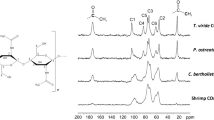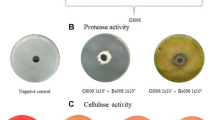Abstract
Four phytopathogenic fungi were cultivated up to six days in media containing chitooligosaccharide mixtures differing in average DP and F A. The three different mixtures were named Q3 (which contained oligosaccharides of DP2–DP10, with DP2–DP7 as main components), Q2 (which contained oligosaccharides of DP2–DP12, with DP2–DP10 as main components) and Q1 (which derived from Q2 and contained oligomers of DP5–DP8 with hexamer and a heptamer as the main components). The novel aspect of this work is the description of the effect of mixtures of oligosaccharides with different and known composition on fungal growth rates. The growth rate of Alternaria alternata and Rhizopus stolonifer was initially inhibited by Q3 and Q2 at higher concentrations. Q1 had a growth stimulating effect on these two fungi. Growth of Botrytis cinerea was inhibited by Q3 and Q2, while Q1 had no effect on the growth of this fungus. Growth of Penicillium expansum was only slightly inhibited by higher concentrations of sample Q3, while Q2 and Q1 had no effect. The inhibition of growth rates or their resistance toward chitooligosaccharides correlated with the absence or presence of chitinolytic enzymes in the culture media, respectively.




Similar content being viewed by others
Abbreviations
- A = GlcNAc:
-
2-Acetamido-2-deoxy-d-glucose
- D = GlcN:
-
2-Amino-2-deoxy-d-glucose
- DHB:
-
2,5-Dihydroxybenzoic acid
- DP:
-
Degree of polymerization
- F A :
-
Mole fraction of GlcNAc residues in chitosan or chitooligosaccharides
- GPC:
-
Gel permeation chromatography
- MALDI TOF MS:
-
Matrix assisted laser desorption ionization time of flight mass spectrometry
- GR:
-
Growth rate
- MEA:
-
Malt extract agar
- PDA:
-
Potato dextrose agar
- CM:
-
Complete medium
References
Peter MG. Chitin and chitosan from fungi. In: Steinbüchel A, editor. Biopolymers, vol. 6. Weinheim: Wiley-VCH; 2002. p. 123–57.
Peter MG. Chitin and chitosan from animal sources. In: Steinbüchel A, editor. Biopolymers, vol. 6. Weinheim: Wiley-VCH; 2002. p. 481–574.
Allan CR, Hadwiger LA. The fungicidal effect of chitosan on fungi of varying cell composition. Exp Mycol. 1979;3:285–7.
Uchida Y, Izume M, Ohtakara A. Preparation of chitosan oligomers with purified chitosanase and its application. In: Skjåk-Bræk G, Anthonsen T, Sandford P, editors. Chitin and chitosan: sources, chemistry, biochemistry, physical properties and applications. London: Elsevier; 1988. p. 373–82.
Yalpani M, Johnson F, Robinson LE. Antimicrobial activity of some chitosan derivatives. In: Brine CJ, Sandford PA, Zikakis JP, editors. Advances in chitin and chitosan. London: Elsevier Applied Science; 1992. p. 543–55.
El Ghaouth A, Arul J, Ponnampalam R, Boulet M. Chitosan coating effect on storability and quality of fresh strawberries. J Food Sci. 1991;56:1618–31.
El Ghaouth A, Arul J, Grenier J, Asselin A. Antifungal activity of chitosan on two postharvest pathogens of strawberry fruits. Phytopathology. 1992;82:398–402.
El Ghaouth A, Arul J, Grenier J, Benhamou N, Asselin A, Belanger R. Effect of chitosan on cucumber plants: suppression of Pythium aphanidermatum and induction of defense reactions. Phytopathology. 1994;84:313–20.
Jiang YM, Li YB. Effects of chitosan coating on postharvest life and quality of longan fruit. Food Chem. 2001;73:139–43.
Bhaskara Reddy MV, Arul J, Angers P, Couture L. Chitosan treatment of wheat seeds induces resistance to Fusarium graminearum and improves seed quality. J Agric Food Chem. 1999;47:1208–16.
Bhaskara Reddy MV, Angers P, Castaigne F, Arul J. Chitosan effects on blackmold rot and pathogenic factors produced by Alternaria alternata in postharvest tomatoes. J Am Soc Hortic Sci. 2000;125:742–7.
Bhaskara Reddy MV, Belkacemi K, Corcuff R, Castaigne F, Arul J. Effect of pre-harvest chitosan sprays on post-harvest infection by Botrytis cinerea and quality of strawberry fruit. Postharvest Biol Technol. 2000;20:39–51.
Hirano S, Nagao N. Effects of chitosan, pectic acid, lysozyme and chitinase on the growth of several phytopathogens. Agric Biol Chem. 1989;53:3065–6.
Zhang M, Tan TW. Insecticidal and fungicidal activities of chitosan and oligo-chitosan. J Bioact Compat Polym. 2003;18:391–400.
Torr KM, Chittenden C, Franich RA, Kreber B. Advances in understanding bioactivity of chitosan and chitosan oligomers against selected wood-inhabiting fungi. Holzforschung. 2005;59:559–67.
Kendra DF, Hadwiger LA. Characterization of the smallest chitosan oligomer that is maximally antifungal to Fusarium solani and elicits pisatin formation by Pisum sativum. Exp Mycol. 1984;8:276–81.
Pontecorvo G. The genetics of Aspergillus nidulans. Adv Genet. 1953;5:150–1.
Langvad F. A rapid and efficient method for growth measurement of filamentous fungi. J Microbiol Methods. 1999;37:97–100.
Trudel J, Asselin A. Detection of chitinase activity after polyacrylamide gel electrophoresis. Anal Biochem. 1989;178:362–6.
Bahrke S, Einarsson JM, Gislason J, Haebel S, Letzel MC, Peter-Katalinic J, Peter MG. Sequence analysis of chitooligosaccharides by matrix-assisted laser desorption ionization postsource decay mass spectrometry. Biomacromolecules. 2002; 3:696–704.
Haebel S, Bahrke S, Peter MG. Quantitative Sequencing of complex mixtures of heterochitooligosaccharides by vMALDI-Linear ion trap mass spectrometry. Anal Chem. 2007;79:5557–66.
Sorbotten A, Horn S J, Eijsink VGH, Varum KM. Degradation of chitosans with chitinase B from Serratia marcescens—production of chito-oligosaccharides and insight into enzyme processivity. FEBS J. 2005;272:538–49.
Vårum KM, Anthonsen MW, Grasdalen H, Smidsrød O. 13C-N.m.r. studies of the acetylation sequences in partially N-deacetylated chitins (chitosans). Carbohydr Res. 1991;217:19–27.
Oliveira-Jr. EN. Caracterização dos efeitos de quitosanas na inibição de fungos fitopatogênicos, PhD. thesis, State University of Campinas (UNICAMP), Brazil, 2006. 106pp.
Suto M, Tomita F. Induction, catabolite repression mechanisms of cellulase in fungi. J Biosci Bioeng. 2001;92(4):305–11.
Amaretti A, Bernardi T, Tamburini E, Zanoni S, Lomma M, Matteuzzi D, Rossi M. Kinetics and metabolism of Bifidobacterium adolescentis MB 239 growing on glucose, galactose, lactose, and galactooligosaccharides. Appl Environ Microbol. 2007; 11:3637–44.
Acknowledgments
Financial support by the Brazilian funding agencies FAPESP, CAPES and CNPq is gratefully acknowledged, as also to the PROBRAL programme (CAPES/DAAD) and to the European Commission (ALFA Programme, II-0259-FA-FC POLYLIFE).
Author information
Authors and Affiliations
Corresponding author
Electronic supplementary material
Below is the link to the electronic supplementary material.
Rights and permissions
About this article
Cite this article
Oliveira, E.N., El Gueddari, N.E., Moerschbacher, B.M. et al. Growth of Phytopathogenic Fungi in the Presence of Partially Acetylated Chitooligosaccharides. Mycopathologia 166, 163–174 (2008). https://doi.org/10.1007/s11046-008-9125-0
Received:
Accepted:
Published:
Issue Date:
DOI: https://doi.org/10.1007/s11046-008-9125-0




